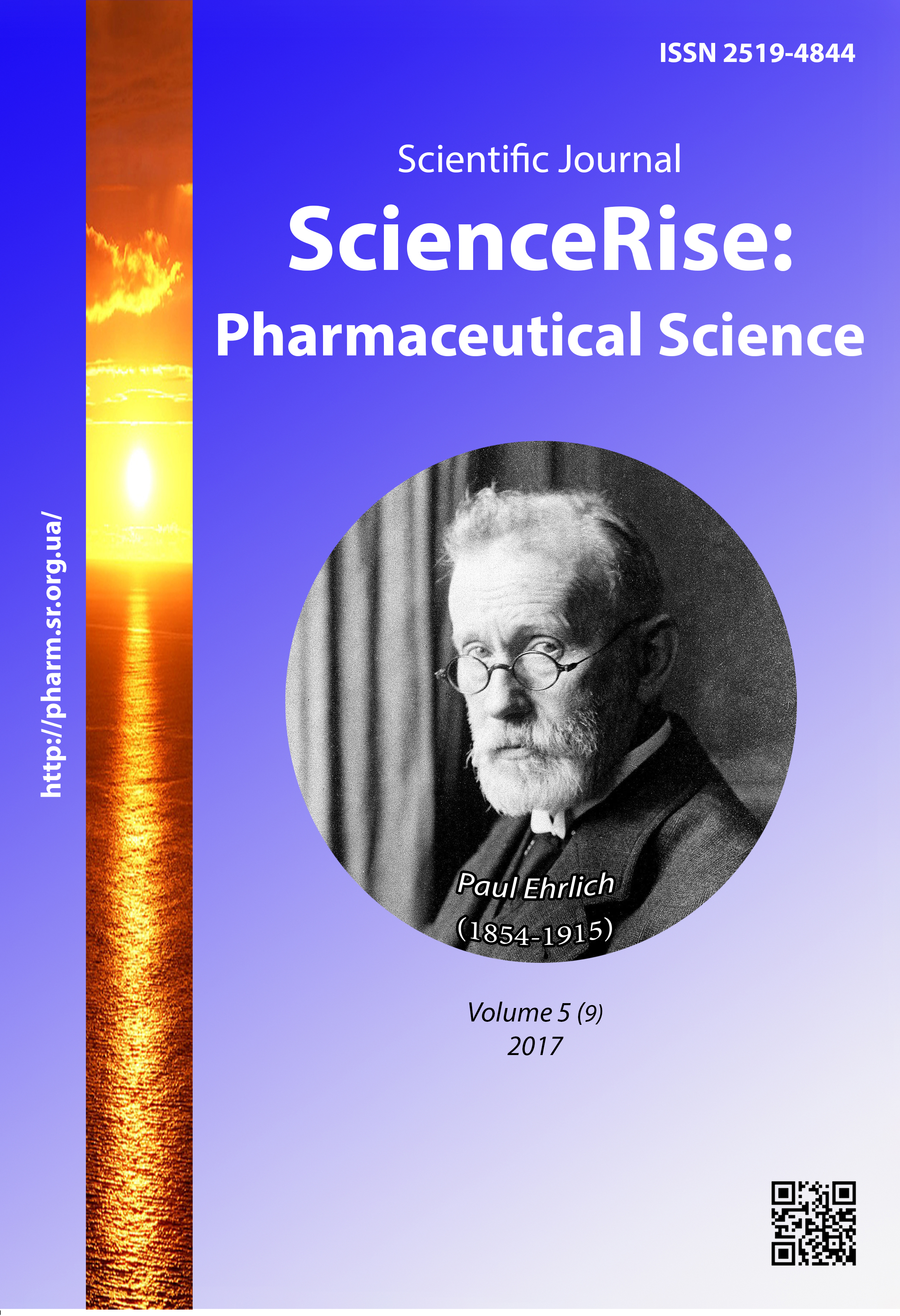Determination of the optimal parameters and ionization products of riboxinum
DOI:
https://doi.org/10.15587/2519-4852.2017.113512Keywords:
derivatives of purine, riboxinum, biological samples, ionization, fragmentation, mass spectrometryAbstract
Currently, mass spectrometry is one of the most widely used rapid methods of analysis; it is used to determine the structure of both individual synthetic and natural organic compounds and their mixtures. One of the ways to determine the structure of the compound studied by this method is the automatic comparison of the spectrum registered with the bank of spectra from the computer database.
Aim. The aim of our work is to determine the optimal parameters of ionization and study the riboxinum fragmentation in ionization with the subsequent replenishment of the library spectra of the device.
Methods. Mass spectrometry was applied using various systems to create both the parent and product ions with the subsequent use of the resulting data to improve selectivity and sensitivity of the method.
Results. As a result of the research conducted the scheme of the riboxinum fragmentation in ionization on a mass spectrometer with a triple quadrupole has been studied. The optimal parameters of the riboxinum ionization have been determined. They are as follows: the ionization mode – positive; a drying gas – 15 L/min; a curtain gas – 8 L/min; the ionization voltage – 5000.0 kV; the temperature of a drying gas – 300.0 °С; the declustering potential – 40.0 V; the focusing potential – 200.0 V; the input potential at Q0 – 10.0 V; the collision energy (Q2) – 20.0 V; the output potential from the collision chamber (Q2) – 25.0 V.
Conclusions. The results obtained are the basis for developing the method for the quantitative determination of riboxinum in biological samples by high-performance liquid chromatography with mass spectrometry-based detection
References
- Farthing, D., Sica, D., Gehr, T., Wilson, B., Fakhry, I., Larus, T. et. al. (2007). An HPLC method for determination of inosine and hypoxanthine in human plasma from healthy volunteers and patients presenting with potential acute cardiac ischemia. Journal of Chromatography B, 854 (1-2), 158–164. doi: 10.1016/j.jchromb.2007.04.013
- Platonova, N. A. (2006). Farmakodinamika bemitila i riboksina u bol'nykh s khronicheskoy serdechnoy nedostatochnost'yu. Vestnik VolgGMU, 1, 50–51.
- Farthing, D. E. (2008). Investigation of inosine and hypoxanthine as biomarkers of cardiac ischemia in plasma of nontraumatic chest pain patients and a rapid analytical system for assessment. Virginia: Virginia Commonwealth University Richmond, 211.
- Hsu, W.-Y., Lin, W.-D., Tsai, Y., Lin, C.-T., Wang, H.-C., Jeng, L.-B. et. al. (2011). Analysis of urinary nucleosides as potential tumor markers in human breast cancer by high performance liquid chromatography/electrospray ionization tandem mass spectrometry. Clinica Chimica Acta, 412 (19-20), 1861–1866. doi: 10.1016/j.cca.2011.06.027
- Kugler, G. (1978). A column chromatographic method for determination of plasma and erythrocyte levels of inosine and hypoxanthine. Analytical Biochemistry, 90 (1), 204–210. doi: 10.1016/0003-2697(78)90024-6
- Chitta, R., Pendela, M., Yekkala, R., Herijgers, P., Hoogmartens, J., Adams, E. (2010). Determination of Adenosine and Inosine in Sheep Plasma Using Solid Phase Extraction Followed by Liquid Chromatography with UV Detection. Analytical Letters, 43 (14), 2267–2274. doi: 10.1080/00032711003717323
- Severini, G., AIlberti, L. M. (1987). Liquid-Chromatographic Determination of Inosine, Xanthine, and Hypoxanthine in Uremic Patients Receiving Hemodialysis Treatment. Clinical Chemistry, 33 (12), 2278–2280.
- Jimmerson, L. C., Bushman, L. R., Ray, M. L., Anderson, P. L., Kiser, J. J. (2016). A LC-MS/MS Method for Quantifying Adenosine, Guanosine and Inosine Nucleotides in Human Cells. Pharmaceutical Research, 34 (1), 73–83. doi: 10.1007/s11095-016-2040-z
- Inoue, K., Obara, R., Hino, T., Oka, H. (2010). Development and Application of an HILIC-MS/MS Method for the Quantitation of Nucleotides in Infant Formula. Journal of Agricultural and Food Chemistry, 58 (18), 9918–9924. doi: 10.1021/jf102023p
- Jabs, C. M., Neglen, P., Ekiof, B., Thomas, E. J. (1990). Adenosine, Inosine, and Hypoxanthine/Xanthine Measured in Tissue and Plasma by a Luminescence Method. Clinical Chemistry, 36 (1), 81–87.
- Zhao, H.-Q., Wang, X., Li, H.-M., Yang, B., Yang, H.-J., Huang, L. (2013). Characterization of Nucleosides and Nucleobases in Natural Cordyceps by HILIC–ESI/TOF/MS and HILIC–ESI/MS. Molecules, 18 (8), 9755–9769. doi: 10.3390/molecules18089755
- Chen, F., Zhang, F., Yang, N., Liu, X. (2014). Simultaneous Determination of 10 Nucleosides and Nucleobases in Antrodia camphorata Using QTRAP LC–MS/MS. Journal of Chromatographic Science, 52 (8), 852–861. doi: 10.1093/chromsci/bmt128
- Klyuev, N. A., Brodskiy, E. S. (2002). Sovremennye metody mass-spektrometricheskogo analiza organicheskikh soedineniy. Rossiyskiy Khimicheskiy Zhurnal, XLVI (4), 57–63.
Downloads
Published
How to Cite
Issue
Section
License
Copyright (c) 2017 Mykola Rosada, Nataliia Bevz, Victoria Georgiyants

This work is licensed under a Creative Commons Attribution 4.0 International License.
Our journal abides by the Creative Commons CC BY copyright rights and permissions for open access journals.








